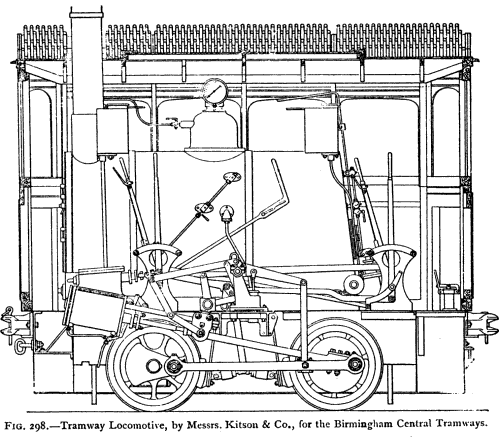This website has been archived from TrainWeb.org/i3 to TrainWeb.US/i3.
![[home]](/i3/graphics/i3.gif) |
Kitson & Co.by D. Kinnear Clark |
contents |
The following is transcribed from a reprint of Tramways - Their Construction and Working, by D. Kinnear Clark, with the kind permission of the publisher.
 Kitson & Co.
Kitson & Co.
The cylinders in this engine, Fig. 298, are placed outside the longitudinal frame-plates, and as high as possible above mud and dust, protected by suitable casings. The engine is on four wheels, coupled. Kitson's patent valve-gear is, with the same object, employed. It is a modification of Walschaert's valve-gear. The ends of a floating lever are linked to the crosshead, the valve spindle, and intermediately at a point near the valve spindle ; the lever is pinned to the radius-link, which receives its rocking movement through an arm linked to the coupling rod. The motion of the valve and its spindle is a compound of two movements: one a movement directly the inverse of that of the piston, on a reduced scale, for the lead; the other a reduced duplicate of the vertical movement of the coupling rod, to open the port for steam. The boiler is of the locomotive type. The exhaust steam is condensed to the extent of two-thirds in a tube-condenser overhead, and one-third is discharged into the chimney, or is condensed by means of a water tank. The engine is provided with a speed indicator and an automatic break. The engines, as employed on the Central Tramways line, Birmingham, weigh, with water and fuel, from 9 tons to 10 tons. They can draw a large car holding 60 passengers.
Messrs. Kitson & Co. construct four standard classes of four-coupled tramway locomotives, as follows: -
| No. of Engine. | ||||
| No. 1. | No. 2. | No. 3. | No. 4. | |
| Cylinders, diameter and stroke | 7¼x12 ins. | 8½x12 ins. | 9x15 ins. | 11½x15 ins. |
| Wheels, diameter | 2ft.4¼ins. | 2ft.4¼ins. | 2ft.10ins. | 2ft.9ins. |
| Water-tank, capacity for water | 80 galls. | 80 galls. | 150 galls. | 250 galls. |
| Weight of engine, empty | 6¾ tons | 7¼ tons | 8 tons | 13¼ tons |
| Weight with water and fuel | 7½ tons | 8½ tons | 10½ tons | 15¼ tons |
| Net load, exclusive of engine weight, that can be taken up an incline of 1 in 25, at a speed of 6 miles per hour | 13 tons | 16 tons | 19 tons | 44 tons |
The cost for working, repairs, and maintenance of Messrs. Kitson & Co.'s engines on two lines of tramways, is summarised in the following statements:
| Miles run. | Per mile run by engines | ||||||||
| Wages. d. |
Fuel. d. |
Water. d. |
Stores. d. |
Repairs. d. |
Sum. d. |
Depreciation, 10 per cent. d. |
Total. d. |
||
| 6 months ending June 30, 1883 |
61,170 | 1.44 | 1.50 | .13 | .35 | .24 | 3.66 | 1.27 | 4.93 |
| 12 months ending June 30, 1884 |
176,528 | 1.41 | .90 | .09 | .08 | .80 | 3.28 | 1.49 | 4.77 |
| 11 months ending May 31, 1885 |
193,204 | 1.43 | .76 | .06 | .25 | 1.12 | 3.62 | 1.12 | 4.74 |
| 29 months ending May 31, 1885 |
430,902 | 1.43 | .92 | .09 | .19 | .86 | 3.49 | 1.29 | 4.78 |
| Miles run. | Per mile run by engines | ||||||||
| Wages. d. |
Fuel. d. |
Water. d. |
Stores. d. |
Repairs. d. |
Sum. d. |
Depreciation, 10 per cent. d. |
Total. d. |
||
| 6 months ending Nov. 30, 1884 |
57,776 | 2.06 | 1.95 | .21 | .17 | .39 | 4.78 | 1.39 | 6.17 |
| 6 months ending May 31, 1885 |
62,128 | 2.14 | 1.95 | .21 | .17 | .39 | 4.78 | 1.39 | 6.61 |
| 12 months ending May 31, 1885 |
119,904 | 2.10 | 1.95 | .21 | .29 | .55 | 5.10 | 1.30 | 6.40 |
| i3@rrmail.com | 2002.07.21 |















